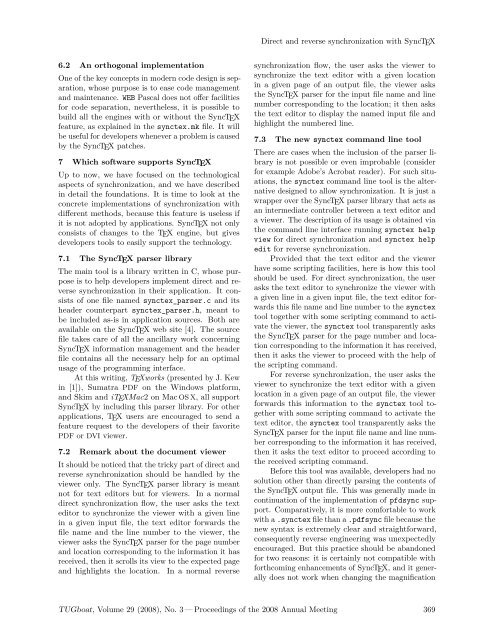The Communications of the TEX Users Group Volume 29 ... - TUG
The Communications of the TEX Users Group Volume 29 ... - TUG
The Communications of the TEX Users Group Volume 29 ... - TUG
Create successful ePaper yourself
Turn your PDF publications into a flip-book with our unique Google optimized e-Paper software.
6.2 An orthogonal implementation<br />
One <strong>of</strong> <strong>the</strong> key concepts in modern code design is separation,<br />
whose purpose is to ease code management<br />
and maintenance. WEB Pascal does not <strong>of</strong>fer facilities<br />
for code separation, never<strong>the</strong>less, it is possible to<br />
build all <strong>the</strong> engines with or without <strong>the</strong> Sync<strong>TEX</strong><br />
feature, as explained in <strong>the</strong> synctex.mk file. It will<br />
be useful for developers whenever a problem is caused<br />
by <strong>the</strong> Sync<strong>TEX</strong> patches.<br />
7 Which s<strong>of</strong>tware supports Sync<strong>TEX</strong><br />
Up to now, we have focused on <strong>the</strong> technological<br />
aspects <strong>of</strong> synchronization, and we have described<br />
in detail <strong>the</strong> foundations. It is time to look at <strong>the</strong><br />
concrete implementations <strong>of</strong> synchronization with<br />
different methods, because this feature is useless if<br />
it is not adopted by applications. Sync<strong>TEX</strong> not only<br />
consists <strong>of</strong> changes to <strong>the</strong> <strong>TEX</strong> engine, but gives<br />
developers tools to easily support <strong>the</strong> technology.<br />
7.1 <strong>The</strong> Sync<strong>TEX</strong> parser library<br />
<strong>The</strong> main tool is a library written in C, whose purpose<br />
is to help developers implement direct and reverse<br />
synchronization in <strong>the</strong>ir application. It consists<br />
<strong>of</strong> one file named synctex_parser.c and its<br />
header counterpart synctex_parser.h, meant to<br />
be included as-is in application sources. Both are<br />
available on <strong>the</strong> Sync<strong>TEX</strong> web site [4]. <strong>The</strong> source<br />
file takes care <strong>of</strong> all <strong>the</strong> ancillary work concerning<br />
Sync<strong>TEX</strong> information management and <strong>the</strong> header<br />
file contains all <strong>the</strong> necessary help for an optimal<br />
usage <strong>of</strong> <strong>the</strong> programming interface.<br />
At this writing, <strong>TEX</strong>works (presented by J. Kew<br />
in [1]), Sumatra PDF on <strong>the</strong> Windows platform,<br />
and Skim and i<strong>TEX</strong>Mac2 on Mac OS X, all support<br />
Sync<strong>TEX</strong> by including this parser library. For o<strong>the</strong>r<br />
applications, <strong>TEX</strong> users are encouraged to send a<br />
feature request to <strong>the</strong> developers <strong>of</strong> <strong>the</strong>ir favorite<br />
PDF or DVI viewer.<br />
7.2 Remark about <strong>the</strong> document viewer<br />
It should be noticed that <strong>the</strong> tricky part <strong>of</strong> direct and<br />
reverse synchronization should be handled by <strong>the</strong><br />
viewer only. <strong>The</strong> Sync<strong>TEX</strong> parser library is meant<br />
not for text editors but for viewers. In a normal<br />
direct synchronization flow, <strong>the</strong> user asks <strong>the</strong> text<br />
editor to synchronize <strong>the</strong> viewer with a given line<br />
in a given input file, <strong>the</strong> text editor forwards <strong>the</strong><br />
file name and <strong>the</strong> line number to <strong>the</strong> viewer, <strong>the</strong><br />
viewer asks <strong>the</strong> Sync<strong>TEX</strong> parser for <strong>the</strong> page number<br />
and location corresponding to <strong>the</strong> information it has<br />
received, <strong>the</strong>n it scrolls its view to <strong>the</strong> expected page<br />
and highlights <strong>the</strong> location. In a normal reverse<br />
Direct and reverse synchronization with Sync<strong>TEX</strong><br />
synchronization flow, <strong>the</strong> user asks <strong>the</strong> viewer to<br />
synchronize <strong>the</strong> text editor with a given location<br />
in a given page <strong>of</strong> an output file, <strong>the</strong> viewer asks<br />
<strong>the</strong> Sync<strong>TEX</strong> parser for <strong>the</strong> input file name and line<br />
number corresponding to <strong>the</strong> location; it <strong>the</strong>n asks<br />
<strong>the</strong> text editor to display <strong>the</strong> named input file and<br />
highlight <strong>the</strong> numbered line.<br />
7.3 <strong>The</strong> new synctex command line tool<br />
<strong>The</strong>re are cases when <strong>the</strong> inclusion <strong>of</strong> <strong>the</strong> parser library<br />
is not possible or even improbable (consider<br />
for example Adobe’s Acrobat reader). For such situations,<br />
<strong>the</strong> synctex command line tool is <strong>the</strong> alternative<br />
designed to allow synchronization. It is just a<br />
wrapper over <strong>the</strong> Sync<strong>TEX</strong> parser library that acts as<br />
an intermediate controller between a text editor and<br />
a viewer. <strong>The</strong> description <strong>of</strong> its usage is obtained via<br />
<strong>the</strong> command line interface running synctex help<br />
view for direct synchronization and synctex help<br />
edit for reverse synchronization.<br />
Provided that <strong>the</strong> text editor and <strong>the</strong> viewer<br />
have some scripting facilities, here is how this tool<br />
should be used. For direct synchronization, <strong>the</strong> user<br />
asks <strong>the</strong> text editor to synchronize <strong>the</strong> viewer with<br />
a given line in a given input file, <strong>the</strong> text editor forwards<br />
this file name and line number to <strong>the</strong> synctex<br />
tool toge<strong>the</strong>r with some scripting command to activate<br />
<strong>the</strong> viewer, <strong>the</strong> synctex tool transparently asks<br />
<strong>the</strong> Sync<strong>TEX</strong> parser for <strong>the</strong> page number and location<br />
corresponding to <strong>the</strong> information it has received,<br />
<strong>the</strong>n it asks <strong>the</strong> viewer to proceed with <strong>the</strong> help <strong>of</strong><br />
<strong>the</strong> scripting command.<br />
For reverse synchronization, <strong>the</strong> user asks <strong>the</strong><br />
viewer to synchronize <strong>the</strong> text editor with a given<br />
location in a given page <strong>of</strong> an output file, <strong>the</strong> viewer<br />
forwards this information to <strong>the</strong> synctex tool toge<strong>the</strong>r<br />
with some scripting command to activate <strong>the</strong><br />
text editor, <strong>the</strong> synctex tool transparently asks <strong>the</strong><br />
Sync<strong>TEX</strong> parser for <strong>the</strong> input file name and line number<br />
corresponding to <strong>the</strong> information it has received,<br />
<strong>the</strong>n it asks <strong>the</strong> text editor to proceed according to<br />
<strong>the</strong> received scripting command.<br />
Before this tool was available, developers had no<br />
solution o<strong>the</strong>r than directly parsing <strong>the</strong> contents <strong>of</strong><br />
<strong>the</strong> Sync<strong>TEX</strong> output file. This was generally made in<br />
continuation <strong>of</strong> <strong>the</strong> implementation <strong>of</strong> pfdsync support.<br />
Comparatively, it is more comfortable to work<br />
with a .synctex file than a .pdfsync file because <strong>the</strong><br />
new syntax is extremely clear and straightforward,<br />
consequently reverse engineering was unexpectedly<br />
encouraged. But this practice should be abandoned<br />
for two reasons: it is certainly not compatible with<br />
forthcoming enhancements <strong>of</strong> Sync<strong>TEX</strong>, and it generally<br />
does not work when changing <strong>the</strong> magnification<br />
<strong>TUG</strong>boat, <strong>Volume</strong> <strong>29</strong> (2008), No. 3 — Proceedings <strong>of</strong> <strong>the</strong> 2008 Annual Meeting 369

















